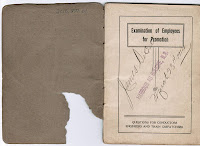One of the biggest pre-holiday tasks was the renewal mail-out. By now you should have all received a little package with your contract, letter, and service cost-analysis. Contracts and payments are due by January 31st, so please take care of this asap. If you have questions feel free to email or phone the office. Remember that we cannot deliver support services without a valid contract.
Young Canada WorksThe deadline for YCW applications is quickly approaching, and this year they've made a couple little changes. Be sure to read all of the fine print for the program outline. Remember that successful applications include references to "big picture" work, such as tying in with community anniversaries, special events, and large-scale initiatives (such as NovaMuse). The federal government is currently gearing up for "the road to 2017", so if you can connect your work to confederation and any upcoming commemorations this will give you a big boost in the adjudication process. Remember to be specific. Feel free to refer to my post on writing funding applications for more tips.
Database Info
In less than a week I will be embroiled in the world of data review. Nomenclature 3.0 and batch editing will be my new best friends, and by the end of January I'll have reviewed & updated over 6000 records. This is going to be very quick work, so please continue to work on updating your georeferences and manufacture dates. This will help be a huge help to me!
Now on to the fun stuff:
We have finally passed the 190,000 record mark! December was a much slower month for everyone (and rightly so), but 385 records and 178 images were added. Our new official tally is 190,278 records and 71,239 images.
By region:
 |
| Port Hastings Museum & Archives Railway Catechism Booklet |
Central: 35,901 artifacts, 13,554 images
Northeast: 30,648 artifacts, 17,569 images
Cape Breton: 25,430 artifacts, 8,249 images
Congrats to the Central region for adding the most records again, and to the Southwest region for adding the most images!
Your image of the month takes us back into the realm of scanning 2-dimensional items. In this case we're looking at the catechism for general train and interlocking rules, ie an instruction booklet for railway workers. Of course by now we all know that this can just be popped into the scanner and a lovely image will result. But it is also important to take secondary and sometimes tertiary images of these items as well. For postcards, you'd want to scan the back to capture the written message. For this book, when it is opened up you see that someone wrote their name and the date inside. We can also see a very clear outline of the tear in the front cover which is important for conservation purposes. So when you are scanning, be sure to look for these kinds of details and get them done while the item is out.
Winding up the Old Year
We only had 3 weeks in the office this month, which gave us a surprising amount of time to come up with some new hair-brained schemes and shenanigans. We had two meetings with the Nova Scotia Museum and Department of Communities, Culture & Heritage to talk about NovaMuse and next steps. We're going to touch base again in early January, but we're already pretty excited about what this might mean.
The Cultural Federations of Nova Scotia, of which ANSM is a part, joined together to host an open house on December 14th. The courtyard was packed with writers, actors, dancers, artists, singers...it was pretty impressive. It even brought Paul Collins out of retirement for the evening.
I also managed to write another book review this month. Click here to check it out.
Ringing in the New Year
I mentioned in November's update that we would be talking with Fleming College again about the possibility of their museum management & curatorship students doing a bit of database work for us. I am very, very pleased to say that this is a go! Next week we will begin ironing out the final details, but I have already identified and approached the 10 sites that we are hoping to partner with the 29 students for a little database cleaning & research work.
Important - if you got an email about this and have not responded, please let me know asap if you want to participate. I have to have the records picked out and accounts ready for the students by the end of January and this takes a bit of time to prepare. If I don't hear back by January 14th you will miss your chance for some extra help.
All for now. Have a safe and happy New Year's Eve, and I look forward to working with you all in 2013.
































